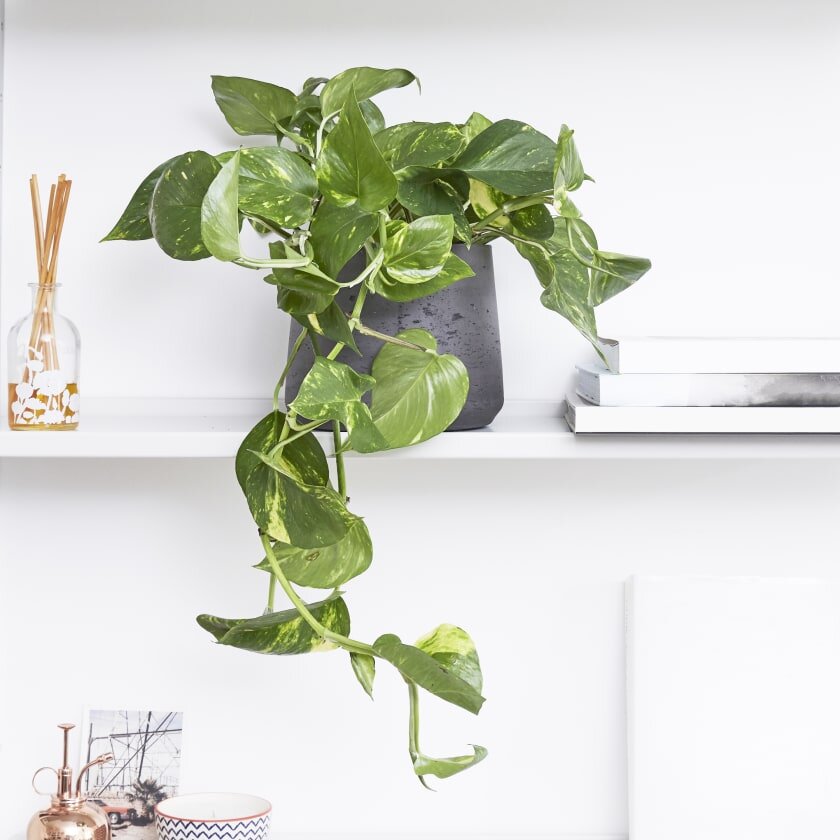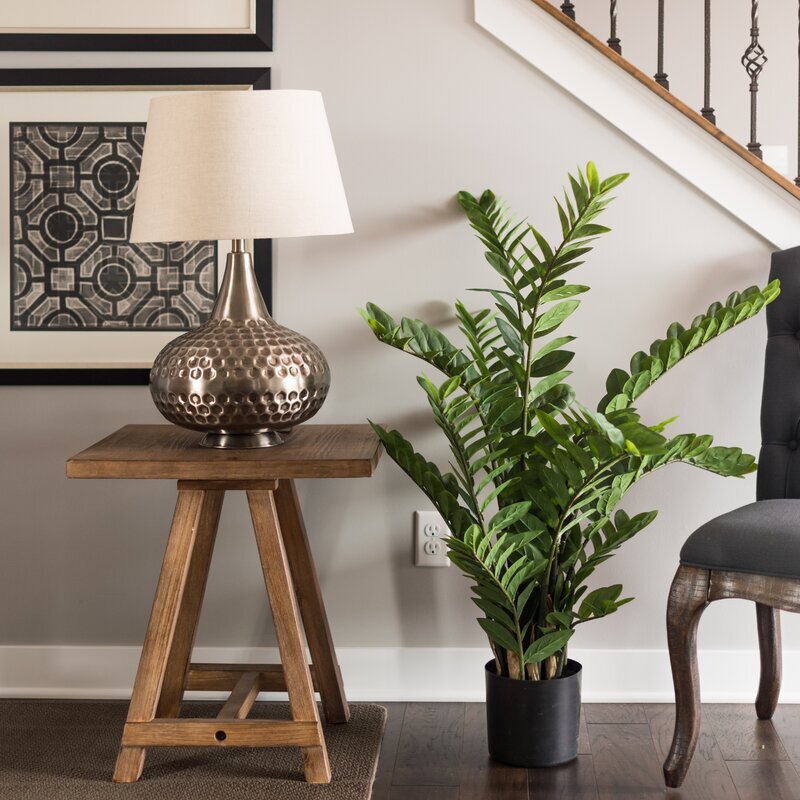When you’re just starting out in the world of indoor gardening, it can be overwhelming. What you need is a plant you like the look of that is easy-going and simple to grow. We’ve compiled a few of our favorites here, with useful information and care tips. The following houseplants are great for beginners and are pretty low-maintenance.
Who knows? Maybe this will be the beginning of a beautiful friendship.
Pothos (Epipremnum aureum)
A pothos is a great houseplant for novices and experts alike. This trailing plant just keeps growing! Train it up an indoor trellis, let it trail down from the top of a bookcase, or hang it in front of a north- or east-facing window. Trimming gangly stems can increase the fullness at the base of the plant and keep it looking lush.
Golden pothos is a variety with lovely yellow and green variegated leaves while ‘Marble Queen’ has creamy white and green variegation. Satin pothos, will velvety leaves flecked with silver, has the botanical name Scindapsus pictus. It is a different species in the same family.
Pothos prefer bright, indirect light but are tolerant of shadier conditions. Soak the plant well, then let the soil dry out somewhat in between waterings. If the plant wilts or leaves yellow and drop, it may need more frequent watering.
Tip: Never let any houseplant sit in water. Instead, empty the saucer or cache pot within 30-45 minutes of watering if there is any standing water.
Spider Plant (Chlorophytum comosum)
The spider plant has been a popular houseplant for generations because of its easy-going attitude and the bonus baby plants that grow at the ends of long stems on the mother. Traditional spider plants have gracefully arching leaves that are bright green with white edges. For a twist, try a curly spider plant; the leaves spiral instead of arching straight. Baby plants can be left attached to the mother plant or rooted in water and then planted separately.
Bright, indirect light is best for spider plants but they will also grow in shady conditions. Water thoroughly and let it dry slightly between waterings (about 1” down). If you notice brown tips on your plant, a lack of humidity may be to blame. Try misting or add a humidifier to the room.
Tip: Lots of houseplants are native to humid, jungle conditions and appreciate a little moisture in the air. Grouping plants together adds humidity, as do trays of pebbles and water (be sure the plants are not sitting in the water), and humidifiers. This is especially important when indoor heat is often running.
ZZ Plant (Zamioculcas zamiifolia)
The ZZ plant is a gorgeous accent plant that thrives without much attention. It’s perfect for a beginner or someone without a lot of time to devote to plant care. ZZ plant is drought tolerant and accepts low-light conditions without fuss. Glossy green leaves grow neatly in pairs off central stems (if you want to sound like an expert, say: “ZZ plant’s phyllotaxis - the arrangement of leaves on a plant stem - is opposite. That means two leaves attach at each point on the stem” and watch your audience gasp in awe.
ZZ prefers moderate to bright indirect light but is very tolerant of low-light conditions. Water thoroughly and allow the soil to dry out quite a bit before watering again. When in doubt, underwater the ZZ (they hate soggy roots).
Tip: More plants are killed by overwatering than underwatering. Always water very deeply, dump out any excess standing water, then wait for the soil to dry out a bit before deeply watering again. How much you let the plant dry out depends on the type of houseplant.
Ponytail Palm (Beaucarnea recurvata)
Dramatic! Unusual! Reminiscent of a desert island! The ponytail palm is definitely a statement plant, especially larger, mature specimens. In fact, it’s not really a palm. Instead, it’s a member of the Agave family and is native to the Mexican desert. The ponytail palm is also very forgiving, drought-tolerant, and easy-going. A great houseplant for those who travel or forget to water.
Give your ponytail palm lots of sun to soak up and it will thank you. It can also tolerate lower light levels, especially in winter. This plant can go several weeks without watering so err on the side of underwatering rather than overwatering, letting the soil dry out nearly completely between waterings. If you see brown and crispy leaves or the trunk begins to wrinkle, it’s been too long - water right away.
Tip: Overwatering and underwatering is less about the quantity of water and more about the frequency. In general, it’s a good idea to water very deeply each time you water. For those plants that like to stay evenly moist, water this way more often. For those that prefer drier conditions, water this way but less often.
Snake Plant (Dracaena trifasciata or Sansevieria trifasciata)
The snake plant is a glutton for punishment. These plants almost seem to appreciate neglect! Well, maybe not neglect, but definitely a hands-off approach. They really are pretty indestructible, weathering drafts, dry air, all light conditions, and infrequent watering. Their sword-like, colorful leaves make them a great statement plant for the home or office.
Snake plants will grow in direct sunshine; bright, indirect light; medium light; even shady corners. Let the plant dry out between waterings and, in the winter months, water very sparingly: just every 1-2 months!
Tip: Houseplants are great air purifiers! NASA has done studies and snake plant, spider plant, and peace lily are at the top of the list of indoor plants that help absorb toxins and clean the air.
Peace Lily (Spathiphyllum wallisii)
Finally, a flowering indoor plant for beginners! The peace lily is known for its glossy green foliage and long-lasting, pure white flowers. The white part of the flower is actually a modified leaf called a spathe. It forms a sheath around the pale yellow stalk, called the spadix, which is covered in tiny flowers. The plant was given its name because the flower stalk and spathe combination look like a waving white flag of surrender.
Peace lilies enjoy bright to medium, indirect light. The brighter the spot, the more flowers the plant will produce. In low light, you will still have a gorgeous foliage plant. Water thoroughly and then let the plant dry out quite a bit before watering again. If it starts to wilt, it’s definitely time to water.
Tip: Most plants appreciate a regular watering schedule. One great method for determining how much a plant has dried out is the weight test: lift the pot after you have watered and feel the weight, then lift again every few days to see how much lighter it feels. As the soil dries out the pot should feel lighter and lighter. Adjust your watering accordingly.
Ready to try one (or all!) of these great plants for beginners and watch your confidence grow? Before you know it you may have a veritable indoor jungle!
We’d love to hear how your forays into houseplant parenthood are going. Comment here or post a note on social media with #heyswansons. We’re always happy to answer any questions you may have!
See more posts about caring for your indoor plants. You can also get a peek at Swansons’ indoor plants and our decorative indoor pottery.







